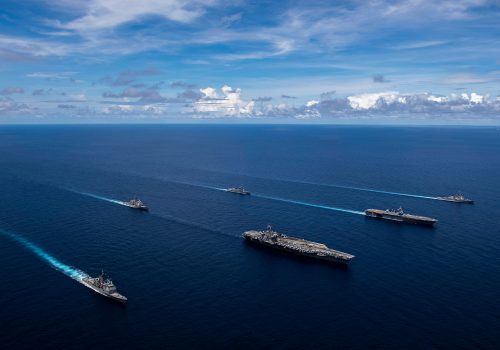President Joe Biden’s National Security Strategy says that the United States has entered a “decisive decade” when it comes to competition with China. But the first comprehensive look at how the administration hopes to implement that strategy—Biden’s $886-billion request for defense-related activities in his fiscal year (FY) 2024 budget—may be insufficient to meet the moment.
The budget does hit the mark in some ways. Secretary of Defense Lloyd Austin called it “the most strategy-driven [budget] request” ever produced for defense. The proposal prioritizes investments needed to implement the 2022 National Defense Strategy (NDS) and necessarily accepts risk in other areas. And the request focuses on improving readiness, boosting procurement of the most-valued munitions, and modernizing—making clear that the United States is highly concerned with preventing war with China in the near term and deterring conflict more generally in the long term.
However, the 3 percent funding increase from FY23 to FY24 may be entirely offset by inflation or even signify a decline in buying power. That means painful trade-offs for the Department of Defense’s (DOD) force structure in personnel and platforms.
The strengths: Implementing the NDS
First, the budget reinforces the view that China is the pacing challenge for the United States. The Pacific Deterrence Initiative, a set of defense investments established by Congress in 2021 in response to China’s growing military power, received its largest investment. Moreover, research-and-development and procurement requests were the largest in DOD history.
The budget places an emphasis on modernization programs that were long deferred, including those for hypersonic weapons, space, cyber, contested logistics, and platforms built for contested environments—all of which will be valuable in deterring China. Modernizing the entire kill chain is also a focus of this budget, in its requests for investments in elements of the DOD’s Joint All-Domain Command and Control strategy, enhanced sensors, and electronic-warfare capabilities. In response to the rapid build-up of China’s nuclear forces, this budget continues to fully fund the revitalization of all legs of the nuclear triad along with nuclear command, control, and communication systems.
The budget has a focus on ensuring that the United States’ advantages endure, as demonstrated through the president’s requested funding for critical emerging technologies, supply-chain resiliency, and the defense workforce. An advantage in technology—especially in artificial intelligence, unmanned systems, directed energy, biotechnologies, and microelectronics—is necessary to keep up with the changing nature of warfare in the coming decade. Shoring up supply chains, specifically ones that are needed to produce defense systems such as metal-fabrication and battery supply chains, is necessary for national security. The budget request, by investing in the research and development of tech across the defense-industrial base, forms the foundation for a self-sustaining defense economy. And, as the all-volunteer force clocks its fiftieth year, the budget shows that the military is, at its core, a people business: The president recommends the largest pay raise for defense personnel in decades (5.2 percent) and notes that military families are key to readiness.
This budget signals an uptick in demand to the defense-industrial base, particularly through increased investment in the most-valued munitions and the execution of a multiyear procurement authority. A stable topline across the Future Years Defense Program (FYDP)—part of the budget request that reflects detailed budget projections over the next five years—provides predictability for industry. Last year, the FYDP provided less predictability because it did not pace inflation each year between 2024 and 2027. Even though its overall increase from FY23 may be offset by inflation, the FY24 request is stable, pacing inflation each year between 2025 and 2028. Last year’s budget also confused industry by not making clear which production lines should be maintained or expanded—but the FY24 budget request makes it clear. The FY24 budget also provides industry-stable procurement counts for the highest-valued aircraft and maritime platforms needed to deter China.
The challenges: Every budget requires trade-offs
How the president chooses to invest in the country’s defense reveals the strategic assumptions he and his leadership team are making about the future fight—and in what areas they are willing to accept risk. The FY24 budget assumes risk in capacity, specifically for the Air Force’s and Navy’s force structures.
The Pentagon is shifting its focus from land wars in the Middle East to deterring high-end conflict with China, and the budget reflects this. The Army and Marine Corps continue to execute previous plans, reinvesting savings from reductions in the number of troops to fund modernization efforts needed for the Indo-Pacific. These modernization efforts include investments in long-range fires, sensing, and air defense. Meanwhile, the Air Force continues trading aircraft capacity for capability—retiring aircraft faster than they can be replaced by deliveries of next-generation or more modern aircraft—resulting in a decrease of total aircraft inventory by 190 in FY24. While modernization (and, accordingly, the trading of legacy systems for advanced capabilities) is necessary for deterring future wars, such decisions inherently assume some level of risk. For example, the Navy’s reduction in battle-force-ship numbers, included in the FY24 request, has implications for the United States’ maritime competitive edge. The decision to truncate production of the San Antonio-class amphibious transport dock impacts all combatant commanders, as these ships are foundational for the United States’ response to contingencies or crises around the globe. Moreover, in the event of a naval blockade of Taiwan, the United States would possibly lack the number of platforms it needs to deploy its response. The People’s Liberation Army Navy is numerically the largest in the world in terms of battle force ships (approximately 340) and is projected to grow to four hundred ships by 2025. In contrast, Biden’s budget request shows a flatlining US naval inventory.
This budget follows guidance from the 2022 Nuclear Posture Review to cancel the nuclear-armed sea-launched cruise missile (SLCM-N) program, even though the program earned bipartisan support as part of the FY23 National Defense Authorization Act (NDAA) and the DOD Appropriations Act. In a tripolar-nuclear-threat environment, the SLCM-N program is a valued capability that is survivable, is prompt, and helps expand the United States’ nuclear deterrence. Expect Congress to push back once again on this misguided request.
What’s next?
As Congress continues hearings on the FY24 NDAA and DOD appropriations bill in the coming months, lawmakers will need to monitor inflation projections and adjudicate whether defense spending should increase above the rate of inflation. They will also need to arbitrate the DOD’s long-term force-structure plans and determine whether deterrence is enhanced by continuing the SLCM-N program. Most importantly, Congress should work to ensure that appropriations are on time so that the DOD is not disadvantaged by the constraints and inefficiencies of beginning nearly every fiscal year under the burden of a continuing resolution.
As Forward Defense’s Commission on Defense Innovation Adoption recommends, Congress should provide increased spending flexibility by spelling out fewer line items, so that the DOD can easily add novel technologies to the force without requiring a new program. The budget process must remain agile, especially given that the services formulate their requests two years before funding is received and their capability needs will evolve within that time.
If the United States is committed to setting up the DOD for an era of strategic competition, it must commit to increasing the defense budget above the rate of inflation to provide the capacity required while not sacrificing readiness and modernization. Otherwise, the US military risks eroding its military edge in the face of a modernized and capable China.
Clementine G. Starling is the director of the Forward Defense program at the Atlantic Council’s Scowcroft Center for Strategy and Security.
Lieutenant Commander Marek Jestrab is the 2022-2023 senior US Navy fellow at the Atlantic Council’s Scowcroft Center for Strategy and Security. These views do not represent the US Navy or the Department of Defense.
Julia Siegel is an assistant director with Forward Defense.
This article is part of the 21st Century Security Project by the Scowcroft Center’s Forward Defense practice with financial support from Lockheed Martin.
Further reading
Mon, Nov 21, 2022
Our military insiders’ views of the new National Defense Strategy
New Atlanticist By
The Scowcroft Center for Strategy and Security’s military fellows weighed in on the NDS, addressing potential gaps between budgets and strategy, and more.
Mon, May 2, 2022
The Pentagon needs a new technology strategy to deter Russia and China, says Lockheed Martin CEO
Transcript By
Lockheed Martin Chairman, President, and Chief Executive Officer James Taiclet joined the Atlantic Council to talk about a security strategy for the twenty-first century.
Wed, Oct 12, 2022
How the US can prepare to deter China and defend Taiwan in the 2020s
Transcript By
Michèle Flournoy discussed how the United States can maintain a credible deterrent against China in the next decade and beyond as part of the Atlantic Council’s Forward Defense Forum.
Image: A US Northrop Grumman E-2 Hawkeye tactical airborne aircraft prepares to take off from the flight deck of the USS Theodore Roosevelt aircraft carrier during a military exercises conducted with the USS Nimitz aircraft carrier in the disputed waters of the South China Sea. Photo via Reuters.



